MaryAnn Bernal's Blog, page 268
June 17, 2014
The Roman legions of Ubrique
The descent to Ocuri along the Roman path from Benaocaz, is now in its fifth year
FRANCISCO GUTIÉRREZ | MALAGA
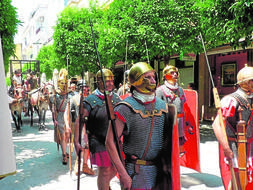 [image error]
[image error]
More than 2,000 years ago, between the 1st and 3rd centuries BC, the Romans were already walking between the oak trees of the Sierra del Benalfí, in the foothills of the Sierra de Grazalema, along one of their famous roads, those works of civil engineering which have resisted the passage of time. Now other Romans, but contemporary ones, are returning to walk these thousand-year-old paths in an event which attracts an increasing number of visitors each year.There has been such as excellent response to this initiative that the organisers have introduced more ambitious elements, so this has become much more than a walk down the Roman path. This year the programme includes activities such as conferences, historic reenactments, gastronomic events and activities for children. On Friday 20th at 8pm, at the Centro de Recepción de Ocuri, a round table discussion will be held about this Roman town, with the participation of historian Luis Javier Guerrero Misa; Giacomo Gillani, a specialist in Classical Literature, and Fine Arts specialist Joaquín Domínguez Ordóñez. On Saturday 21st at 9pm, this same reception centre will be the venue for a performance of the classical ‘Fabula Belli Troiani’ by the ¿Tea Tre Ves? Theatre Workshop of Ubrique. After that, the II Convivivm Ocvritanorvm will take place, with a typical Roman menu prepared with products and recipes from the era. Roman marketThe actual descent down the Roman trail itself will take place on Saturday 28th. On the Friday, at 6pm, a Roman market will be held in the Town Hall square (Plaza del Ayuntamiento), organised by Andalucía Medieval. Then at 8pm, the Cohors Praetoria Ocvritanorvm and the Legio X Eqvestris will take part in a street procession which starts at the Plaza de la Estrella and finishes at the Plaza del Ayuntamiento. On the Saturday from 4.45pm, the people who want to take part in the descent along the Roman path leave from the bus station. The bus will take them to the starting point of the walk, in the neighbouring municipality of Benaocaz. The only condition for taking part is that people dress as Romans. The Roman legions are expected to arrive at the Plaza del Ayuntamiento at 9pm. The following day, Sunday, there will be a children’s procession at midday, with the youngsters dressed as Romans, and a puppet show. The festival closes with a firework display. The Roman path down which the ‘descent’ takes place is included in the catalogue of footpaths in the Sierra de Grazalema natural park. In Benaocaz, it begins on the A-2302, beside the bus stop for the village. If we start in Ubrique, we need to look for the church of San Juan. The footpath goes continually downhill through limestone landscapes with dolomites, clay and gypsum, and there are some lovely views of the Alta and Ubrique mountain ranges. Baths and forumHowever, Ocuri is neither a legend nor the fruit of historians’ imagination. The path passes below the Salto de la Mora, where the remains of the Roman town are situated. Surrounded by a formidable wall and with impressive infrastructure such as water deposits and channels, we find the remains of public baths, houses, the forum and the cemetery, which were built during the 2nd century BC. This complex can be visited from the information point at kilometre 20 on the road between Ubrique and Benaocaz. A stretch of the wall is still intact, about 26 metres in length, three metres wide and an average height of 2.14 metres, and experts believe the wall, which was built for defensive purposes, was originally about 40 metres long and was constructed in the 5th century BC. In 2012 the wall suffered major damage and part of it collapsed. At present, restoration works are being carried out on these stretches and to consolidate the span of the entrance to the archaeological site. The path continues downwards to the stone, or head, of the bull (a bull’s head is painted on the rock). Legend has it that a battle took place at this point between the inhabitants of Benaocaz and Ubrique over the image of San Blas. They hurled rocks at each other because the people of Ubrique tried to steal the image as a mate for the Virgen de los Remedios. It is here that the organisers of the ‘Bajada’ designed the ‘ocuritaurus’, a bull’s head made out of fibreglass which has become a legendary totem. Once the participants arrive at Ubrique, the Romans who have taken part in the Bajada for the first time are baptised in the ‘fountain of nine spouts’ and are given names from that era. Interesting places in Ubrique include the Capuchinos convent, which is a 17th century church, the 18th century chapel of El Calvario and the parish church of Nuestra Señora de la O, built in 1773. The image of Nuestra Señora de la O is the work of sculptor Jerónimo Hernández. It was created in 1575 and painted by Álvaro de Ovalle in 1576. It was originally in the El Salvador church in Carmona. In the chapel of El Sagrario is a painting of the Immaculate Conception attributed to Italian artist Lucas Jordán, highlighting the beautiful and magnificent silver tabernacle which was created by the Navas Parejo goldsmiths in Granada. LeatherThe town’s principal industry is leather and there is now a Leather Museum, the Museo de la Piel de Ubrique, which is situated in the Convento de los Capuchinos, in the rooms which were once the cells of the friars. http://www.surinenglish.com/20140613/news/costasol-malaga/roman-legions-ubrique-201406131716.html
FRANCISCO GUTIÉRREZ | MALAGA
 [image error]
[image error]
More than 2,000 years ago, between the 1st and 3rd centuries BC, the Romans were already walking between the oak trees of the Sierra del Benalfí, in the foothills of the Sierra de Grazalema, along one of their famous roads, those works of civil engineering which have resisted the passage of time. Now other Romans, but contemporary ones, are returning to walk these thousand-year-old paths in an event which attracts an increasing number of visitors each year.There has been such as excellent response to this initiative that the organisers have introduced more ambitious elements, so this has become much more than a walk down the Roman path. This year the programme includes activities such as conferences, historic reenactments, gastronomic events and activities for children. On Friday 20th at 8pm, at the Centro de Recepción de Ocuri, a round table discussion will be held about this Roman town, with the participation of historian Luis Javier Guerrero Misa; Giacomo Gillani, a specialist in Classical Literature, and Fine Arts specialist Joaquín Domínguez Ordóñez. On Saturday 21st at 9pm, this same reception centre will be the venue for a performance of the classical ‘Fabula Belli Troiani’ by the ¿Tea Tre Ves? Theatre Workshop of Ubrique. After that, the II Convivivm Ocvritanorvm will take place, with a typical Roman menu prepared with products and recipes from the era. Roman marketThe actual descent down the Roman trail itself will take place on Saturday 28th. On the Friday, at 6pm, a Roman market will be held in the Town Hall square (Plaza del Ayuntamiento), organised by Andalucía Medieval. Then at 8pm, the Cohors Praetoria Ocvritanorvm and the Legio X Eqvestris will take part in a street procession which starts at the Plaza de la Estrella and finishes at the Plaza del Ayuntamiento. On the Saturday from 4.45pm, the people who want to take part in the descent along the Roman path leave from the bus station. The bus will take them to the starting point of the walk, in the neighbouring municipality of Benaocaz. The only condition for taking part is that people dress as Romans. The Roman legions are expected to arrive at the Plaza del Ayuntamiento at 9pm. The following day, Sunday, there will be a children’s procession at midday, with the youngsters dressed as Romans, and a puppet show. The festival closes with a firework display. The Roman path down which the ‘descent’ takes place is included in the catalogue of footpaths in the Sierra de Grazalema natural park. In Benaocaz, it begins on the A-2302, beside the bus stop for the village. If we start in Ubrique, we need to look for the church of San Juan. The footpath goes continually downhill through limestone landscapes with dolomites, clay and gypsum, and there are some lovely views of the Alta and Ubrique mountain ranges. Baths and forumHowever, Ocuri is neither a legend nor the fruit of historians’ imagination. The path passes below the Salto de la Mora, where the remains of the Roman town are situated. Surrounded by a formidable wall and with impressive infrastructure such as water deposits and channels, we find the remains of public baths, houses, the forum and the cemetery, which were built during the 2nd century BC. This complex can be visited from the information point at kilometre 20 on the road between Ubrique and Benaocaz. A stretch of the wall is still intact, about 26 metres in length, three metres wide and an average height of 2.14 metres, and experts believe the wall, which was built for defensive purposes, was originally about 40 metres long and was constructed in the 5th century BC. In 2012 the wall suffered major damage and part of it collapsed. At present, restoration works are being carried out on these stretches and to consolidate the span of the entrance to the archaeological site. The path continues downwards to the stone, or head, of the bull (a bull’s head is painted on the rock). Legend has it that a battle took place at this point between the inhabitants of Benaocaz and Ubrique over the image of San Blas. They hurled rocks at each other because the people of Ubrique tried to steal the image as a mate for the Virgen de los Remedios. It is here that the organisers of the ‘Bajada’ designed the ‘ocuritaurus’, a bull’s head made out of fibreglass which has become a legendary totem. Once the participants arrive at Ubrique, the Romans who have taken part in the Bajada for the first time are baptised in the ‘fountain of nine spouts’ and are given names from that era. Interesting places in Ubrique include the Capuchinos convent, which is a 17th century church, the 18th century chapel of El Calvario and the parish church of Nuestra Señora de la O, built in 1773. The image of Nuestra Señora de la O is the work of sculptor Jerónimo Hernández. It was created in 1575 and painted by Álvaro de Ovalle in 1576. It was originally in the El Salvador church in Carmona. In the chapel of El Sagrario is a painting of the Immaculate Conception attributed to Italian artist Lucas Jordán, highlighting the beautiful and magnificent silver tabernacle which was created by the Navas Parejo goldsmiths in Granada. LeatherThe town’s principal industry is leather and there is now a Leather Museum, the Museo de la Piel de Ubrique, which is situated in the Convento de los Capuchinos, in the rooms which were once the cells of the friars. http://www.surinenglish.com/20140613/news/costasol-malaga/roman-legions-ubrique-201406131716.html

Published on June 17, 2014 15:07
History Trivia - Battle of Deptford Bridge
June 17

1194 Richard I (the Lionheart) was crowned again, after having been held captive in Australia for two years by Emperor Henry VI.

1239 Edward I was born.

1497 Cornish Rebellion - Battle of Deptford Bridge – forces under King Henry VII defeated troops led by Michael An Gof.


1194 Richard I (the Lionheart) was crowned again, after having been held captive in Australia for two years by Emperor Henry VI.

1239 Edward I was born.

1497 Cornish Rebellion - Battle of Deptford Bridge – forces under King Henry VII defeated troops led by Michael An Gof.

Published on June 17, 2014 04:35
June 16, 2014
Remains of 'End of the World' Epidemic Found in Ancient Egypt
By Owen Jarus,
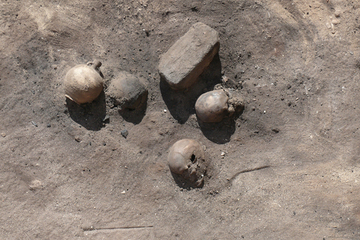
 Here, a bonfire where many of the victims of an ancient epidemic in the ancient city of Thebes in Egypt were ultimately incinerated.
Here, a bonfire where many of the victims of an ancient epidemic in the ancient city of Thebes in Egypt were ultimately incinerated.
Credit: Photo by N. Cijan © Associazione Culturale per lo Studio dell’Egitto e del Sudan ONLUS. View full size image
Archaeologists have uncovered the remains of an epidemic in Egypt so terrible that one ancient writer believed the world was coming to an end.
Working at the Funerary Complex of Harwa and Akhimenru in the west bank of the ancient city of Thebes (modern-day Luxor) in Egypt, the team of the Italian Archaeological Mission to Luxor (MAIL) found bodies covered with a thick layer of lime (historically used as a disinfectant). The researchers also found three kilns where the lime was produced, as well as a giant bonfire containing human remains, where many of the plague victims were incinerated.
Pottery remains found in the kilns allowed researchers to date the grisly operation to the third century A.D., a time when a series of epidemics now dubbed the "Plague of Cyprian" ravaged the Roman Empire, which included Egypt. Saint Cyprian was a bishop of Carthage (a city in Tunisia) who described the plague as signaling the end of the world
Occurring between roughly A.D. 250-271, the plague "according to some sources killed more than 5,000 people a day in Rome alone," wrote Francesco Tiradritti, director of the MAIL, in the latest issue of Egyptian Archaeology, a magazine published by the Egypt Exploration Society.
Tiradritti's team uncovered the remains of this body-disposal operation between 1997 and 2012. The monument his team is excavating was originally built in the seventh century B.C. for a grand steward named Harwa. After Harwa's death, the Egyptians continuously used the monument for burial (Akhimenru was a successor who built his own tomb there). However, after its use for body disposal during the plague, the monument was abandoned and never used again.
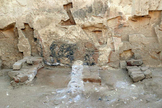 [image error]
[image error]
 A lime kiln built to produce enough lime disinfectant to cover the human remains of victims from the epidemic in the ancient city of Thebes.
A lime kiln built to produce enough lime disinfectant to cover the human remains of victims from the epidemic in the ancient city of Thebes.
Credit: Photo by N. Cijan © Associazione Culturale per lo Studio dell’Egitto e del Sudan ONLUS.View full size imageThe use of the complex "for the disposal of infected corpses gave the monument a lasting bad reputation and doomed it to centuries of oblivion until tomb robbers entered the complex in the early 19th century," Tiradritti writes.
End of the world
Cyprian left a gut-wrenching record of what the victims suffered before they died. "The bowels, relaxed into a constant flux, discharge the bodily strength [and] a fire originated in the marrow ferments into wounds of the fauces (an area of the mouth)," he wrote in Latin in a work called "De mortalitate." The "intestines are shaken with a continual vomiting, [and] the eyes are on fire with the injected blood," he wrote, adding that "in some cases the feet or some parts of the limbs are taken off by the contagion of diseased putrefaction …"
Cyprian believed that the world was coming to an end.
"The kingdom of God, beloved brethren, is beginning to be at hand; the reward of life, and the rejoicing of eternal salvation, and the perpetual gladness and possession lately lost of paradise, are now coming, with the passing away of the world …" (translation by Philip Schaff, from the book "Ante-Nicene Fathers", volume 5, 1885).
While the world, of course, did not end, the plague weakened the Roman Empire. "It killed two Emperors, Hostilian in A.D. 251 and Claudius II Gothicus in A.D. 270," wrote Tiradritti. It is "a generally held opinion that the 'Plague of Cyprian' seriously weakened the Roman Empire, hastening its fall." [In Photos: 14th-Century 'Black Death' Grave Discovered]
The newly unearthed remains at Luxor underscore the plague's potency. Tiradritti'steam found no evidence that the victims received any sort of religious rites during their incineration. "We found evidence of corpses either burned or buried inside the lime," he told Live Science in an interview. "They had to dispose of them without losing any time."
What caused the plague?
The plague may have been some form of smallpox or measles, accordingto modern day scientists. While the discovery of human remains associated with the plague will give anthropologists new material to study, Tiradritti cautions they will not be able to extract DNA from the bodies.
While stories about researchers extracting DNA from mummies (such as Tutankhamun) have made headlines in recent years, Tiradritti told Live Science he doesn't believe the results from such ancient specimens. "In a climate like Egypt, the DNA is completely destroyed," he said. DNA breaks down over time, and permafrost (something not found in Egypt) is the best place to find ancient DNA samples, Tiradritti said.
Immense monument
The discovery of the body disposal site is just one part of the team's research. Thebes is a massive site containing a vast necropolis, and the excavations of the MAIL are providing new data that allows scholars to determine how it changed between the seventh century B.C. and today.
The funerary complex of Harwa and Akhimenru, which the MAIL has been excavating since 1995, is one of the largest private funerary monuments of Egypt. Tiradritti notes that it is considered a key monument for studying a peak period in Egyptian art known as the "Pharaonic Renaissance" that lasted from the start of the seventh century B.C. until the mid-sixth century B.C. During this time, Tiradritti notes, artists created innovative new works that were rooted in older Egyptian artistic traditions.
http://www.livescience.com/46335-remains-of-ancient-egypt-epidemic-found.html

 Here, a bonfire where many of the victims of an ancient epidemic in the ancient city of Thebes in Egypt were ultimately incinerated.
Here, a bonfire where many of the victims of an ancient epidemic in the ancient city of Thebes in Egypt were ultimately incinerated. Credit: Photo by N. Cijan © Associazione Culturale per lo Studio dell’Egitto e del Sudan ONLUS. View full size image
Archaeologists have uncovered the remains of an epidemic in Egypt so terrible that one ancient writer believed the world was coming to an end.
Working at the Funerary Complex of Harwa and Akhimenru in the west bank of the ancient city of Thebes (modern-day Luxor) in Egypt, the team of the Italian Archaeological Mission to Luxor (MAIL) found bodies covered with a thick layer of lime (historically used as a disinfectant). The researchers also found three kilns where the lime was produced, as well as a giant bonfire containing human remains, where many of the plague victims were incinerated.
Pottery remains found in the kilns allowed researchers to date the grisly operation to the third century A.D., a time when a series of epidemics now dubbed the "Plague of Cyprian" ravaged the Roman Empire, which included Egypt. Saint Cyprian was a bishop of Carthage (a city in Tunisia) who described the plague as signaling the end of the world
Occurring between roughly A.D. 250-271, the plague "according to some sources killed more than 5,000 people a day in Rome alone," wrote Francesco Tiradritti, director of the MAIL, in the latest issue of Egyptian Archaeology, a magazine published by the Egypt Exploration Society.
Tiradritti's team uncovered the remains of this body-disposal operation between 1997 and 2012. The monument his team is excavating was originally built in the seventh century B.C. for a grand steward named Harwa. After Harwa's death, the Egyptians continuously used the monument for burial (Akhimenru was a successor who built his own tomb there). However, after its use for body disposal during the plague, the monument was abandoned and never used again.
 [image error]
[image error]
 A lime kiln built to produce enough lime disinfectant to cover the human remains of victims from the epidemic in the ancient city of Thebes.
A lime kiln built to produce enough lime disinfectant to cover the human remains of victims from the epidemic in the ancient city of Thebes.Credit: Photo by N. Cijan © Associazione Culturale per lo Studio dell’Egitto e del Sudan ONLUS.View full size imageThe use of the complex "for the disposal of infected corpses gave the monument a lasting bad reputation and doomed it to centuries of oblivion until tomb robbers entered the complex in the early 19th century," Tiradritti writes.
End of the world
Cyprian left a gut-wrenching record of what the victims suffered before they died. "The bowels, relaxed into a constant flux, discharge the bodily strength [and] a fire originated in the marrow ferments into wounds of the fauces (an area of the mouth)," he wrote in Latin in a work called "De mortalitate." The "intestines are shaken with a continual vomiting, [and] the eyes are on fire with the injected blood," he wrote, adding that "in some cases the feet or some parts of the limbs are taken off by the contagion of diseased putrefaction …"
Cyprian believed that the world was coming to an end.
"The kingdom of God, beloved brethren, is beginning to be at hand; the reward of life, and the rejoicing of eternal salvation, and the perpetual gladness and possession lately lost of paradise, are now coming, with the passing away of the world …" (translation by Philip Schaff, from the book "Ante-Nicene Fathers", volume 5, 1885).
While the world, of course, did not end, the plague weakened the Roman Empire. "It killed two Emperors, Hostilian in A.D. 251 and Claudius II Gothicus in A.D. 270," wrote Tiradritti. It is "a generally held opinion that the 'Plague of Cyprian' seriously weakened the Roman Empire, hastening its fall." [In Photos: 14th-Century 'Black Death' Grave Discovered]
The newly unearthed remains at Luxor underscore the plague's potency. Tiradritti'steam found no evidence that the victims received any sort of religious rites during their incineration. "We found evidence of corpses either burned or buried inside the lime," he told Live Science in an interview. "They had to dispose of them without losing any time."
What caused the plague?
The plague may have been some form of smallpox or measles, accordingto modern day scientists. While the discovery of human remains associated with the plague will give anthropologists new material to study, Tiradritti cautions they will not be able to extract DNA from the bodies.
While stories about researchers extracting DNA from mummies (such as Tutankhamun) have made headlines in recent years, Tiradritti told Live Science he doesn't believe the results from such ancient specimens. "In a climate like Egypt, the DNA is completely destroyed," he said. DNA breaks down over time, and permafrost (something not found in Egypt) is the best place to find ancient DNA samples, Tiradritti said.
Immense monument
The discovery of the body disposal site is just one part of the team's research. Thebes is a massive site containing a vast necropolis, and the excavations of the MAIL are providing new data that allows scholars to determine how it changed between the seventh century B.C. and today.
The funerary complex of Harwa and Akhimenru, which the MAIL has been excavating since 1995, is one of the largest private funerary monuments of Egypt. Tiradritti notes that it is considered a key monument for studying a peak period in Egyptian art known as the "Pharaonic Renaissance" that lasted from the start of the seventh century B.C. until the mid-sixth century B.C. During this time, Tiradritti notes, artists created innovative new works that were rooted in older Egyptian artistic traditions.
http://www.livescience.com/46335-remains-of-ancient-egypt-epidemic-found.html

Published on June 16, 2014 16:50
Mr. Chuckles stopped by the Wizard's Cauldron, checking out The Bookshop on the Corner
 The Wizard Speaks:
The Wizard Speaks:Sarah Smith had an addiction — she was addicted to romance novels. The meet-cute, the passion, the drama and the gorgeous men! Now this wouldn’t have been such an issue if she hadn’t been the owner of the only bookshop in Ashford, Connecticut.
Ever since her close friend Lil, from the Gingerbread Café, had become engaged she had been yearning for a little love to turn up in her life. Except Sarah knew a good man was hard to find — especially in a tiny town like Ashford.
That was until New York journalist, Ridge Warner, stepped into her bookshop…
Love could be just around the corner for Sarah, but will she be able to truly believe that happy-ever-after can happen in real-life too?
Click on the link to read more:
http://greenwizard62.blogspot.co.uk/2014/06/rebecca-raisin-launches-bookshop-on.html

Published on June 16, 2014 05:23
My Writing Process Blog Hop
Many thanks to Gev Sweeney who invited me to participate in this blog hop.
About Gev:
Gev has been telling tales since sixth grade, when she was caught daydreaming about a failed jungle expedition. She grew up to become a journalist who did everything from getting caught in a riot to shooting a Brown Bess. She advocates historic authenticity in fiction but forgives Shakespeare for all those horrid anachronisms in Julius Caesar. The best part of doing research for The Scattered Proud was reading bound volumes of the French Revolutionary newspaper le Moniteur universel on a lower level of Princeton University’s Firestone Library, beneath the cold, craggy scowl of Rodin’s hideous bust of Balzac.
Born in Paterson, New Jersey, Gev holds an M.A. in the History and Theory of Music from Rutgers University and an M.A. in Corporate and Public Communication from Monmouth University. She now lives at the Jersey Shore with Baby Auden and Philip Baby-Boar, a pair of plump, cuddly guinea pigs who have a loving following in the real world and online.
http://gevsweeney.wordpress.com/2014/06/09/the-writing-process/
Now for the questions:
What am I working on?
Currently, I am producing audio editions of my published works. The Briton and the Dane and The Briton and the Dane: Timeline are in production and should be available on Audible and iTunes by mid-July. The audio version of the remaining titles in the franchise will be available in the near future.
How does my work differ from others of its genre?
I delve into the mindset of the characters, presenting two sides of the coin, creating a gray area, which might have the reader becoming sympathetic to the villain's plight. There are many conflicting emotions throughout my novels pertaining to religion, paternal approval and the effect deployment has on military families.
Why do I write what I do?
After reading Sir Walter Scott's "Ivanhoe", I became enthralled with early British history and admit to being an incurable romantic Anglophile.
How does my writing process work?
Once I've completed the story, I set it aside for a week before reading it again, but wearing my editor's cap. I then submit the manuscript to my editor for a final review. Next step is Whispering Legends Press publishing the work.
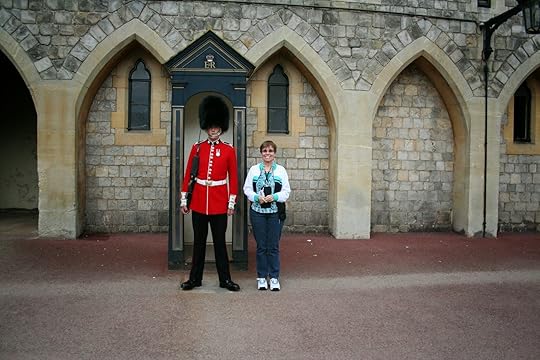
www.maryannbernal.com
www.whisperinglegendspress.com

About Gev:
Gev has been telling tales since sixth grade, when she was caught daydreaming about a failed jungle expedition. She grew up to become a journalist who did everything from getting caught in a riot to shooting a Brown Bess. She advocates historic authenticity in fiction but forgives Shakespeare for all those horrid anachronisms in Julius Caesar. The best part of doing research for The Scattered Proud was reading bound volumes of the French Revolutionary newspaper le Moniteur universel on a lower level of Princeton University’s Firestone Library, beneath the cold, craggy scowl of Rodin’s hideous bust of Balzac.
Born in Paterson, New Jersey, Gev holds an M.A. in the History and Theory of Music from Rutgers University and an M.A. in Corporate and Public Communication from Monmouth University. She now lives at the Jersey Shore with Baby Auden and Philip Baby-Boar, a pair of plump, cuddly guinea pigs who have a loving following in the real world and online.
http://gevsweeney.wordpress.com/2014/06/09/the-writing-process/
Now for the questions:
What am I working on?
Currently, I am producing audio editions of my published works. The Briton and the Dane and The Briton and the Dane: Timeline are in production and should be available on Audible and iTunes by mid-July. The audio version of the remaining titles in the franchise will be available in the near future.
How does my work differ from others of its genre?
I delve into the mindset of the characters, presenting two sides of the coin, creating a gray area, which might have the reader becoming sympathetic to the villain's plight. There are many conflicting emotions throughout my novels pertaining to religion, paternal approval and the effect deployment has on military families.
Why do I write what I do?
After reading Sir Walter Scott's "Ivanhoe", I became enthralled with early British history and admit to being an incurable romantic Anglophile.
How does my writing process work?
Once I've completed the story, I set it aside for a week before reading it again, but wearing my editor's cap. I then submit the manuscript to my editor for a final review. Next step is Whispering Legends Press publishing the work.

www.maryannbernal.com
www.whisperinglegendspress.com

Published on June 16, 2014 04:10
History Trivia - Rome sacked by Vandal army
June 16
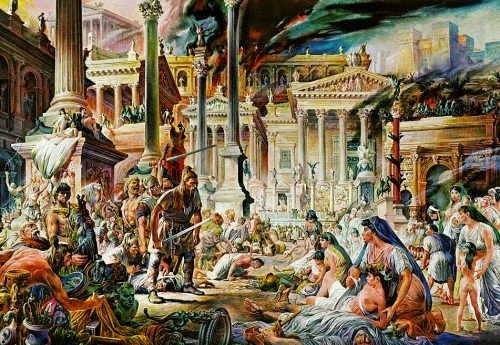
455 Rome was sacked by the Vandal army.
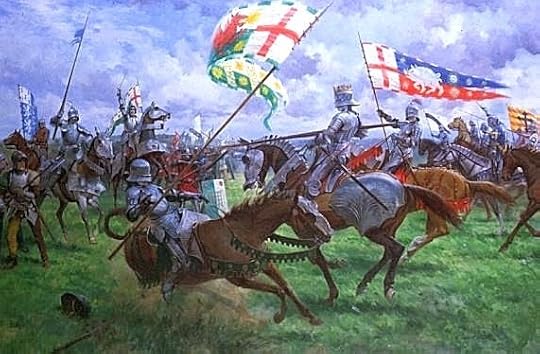
1487 Battle of Stoke Field, Henry VII defeated pretender Lambert Simnel at Stoke, in the final battle of the Wars of the Roses.
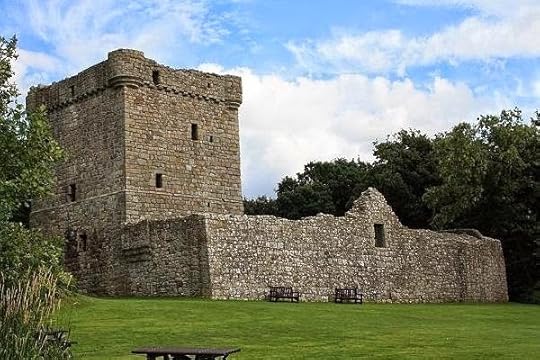
1567 Mary, Queen of Scots, was imprisoned in Lochleven Castle prison Scotland since she was perceived as a threat to Elizabeth I's monarchy.


455 Rome was sacked by the Vandal army.

1487 Battle of Stoke Field, Henry VII defeated pretender Lambert Simnel at Stoke, in the final battle of the Wars of the Roses.

1567 Mary, Queen of Scots, was imprisoned in Lochleven Castle prison Scotland since she was perceived as a threat to Elizabeth I's monarchy.

Published on June 16, 2014 04:09
June 15, 2014
History Trivia - El Cid captures Valencia from the Moors
June 15

763 BC Assyrians recorded a solar eclipse that was later used to fix the chronology of Mesopotamian history.
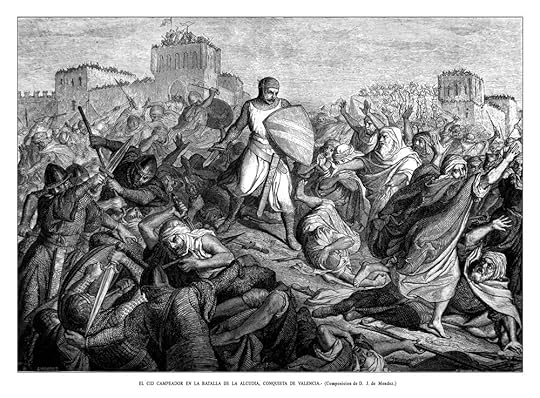
1094, El Cid, the great Spanish national hero, captured Valencia from the Moors.
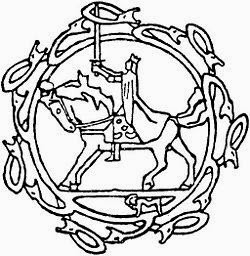
1184 King Magnus V of Norway was killed at the Battle of Fimreite.
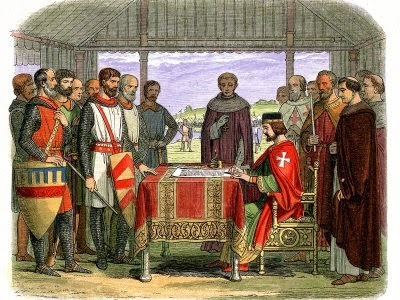
1215 Magna Carta sealed: Following a revolt by the English nobility against his rule, King John puts his royal seal on the Magna Carta, or "Great Charter."

1219 King Valdemar brought victory for Denmark. According to legend, the Danish flag fell from the sky during the Battle of Lyndanisse (now Tallinn) in Estonia, turning the tide in favor of the Danes.

1330 Edward, the Black Prince was born.

1381 Wat Tyler, leader of English Peasants' Revolt, was beheaded in London.

1520 Pope Leo X threatened to excommunicate Martin Luther in papal bull Exsurge Domine.


763 BC Assyrians recorded a solar eclipse that was later used to fix the chronology of Mesopotamian history.

1094, El Cid, the great Spanish national hero, captured Valencia from the Moors.

1184 King Magnus V of Norway was killed at the Battle of Fimreite.

1215 Magna Carta sealed: Following a revolt by the English nobility against his rule, King John puts his royal seal on the Magna Carta, or "Great Charter."

1219 King Valdemar brought victory for Denmark. According to legend, the Danish flag fell from the sky during the Battle of Lyndanisse (now Tallinn) in Estonia, turning the tide in favor of the Danes.

1330 Edward, the Black Prince was born.

1381 Wat Tyler, leader of English Peasants' Revolt, was beheaded in London.

1520 Pope Leo X threatened to excommunicate Martin Luther in papal bull Exsurge Domine.

Published on June 15, 2014 04:42
June 14, 2014
Million-Year-Old Fossils Show Hippos Going for a Swim
By Megan Gannon
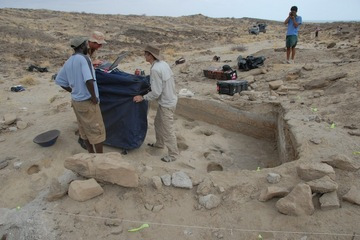
 Researchers in Kenya have uncovered fossilized animal tracks, which they believe may have been left by swimming hippos 1.4 million years ago.
Researchers in Kenya have uncovered fossilized animal tracks, which they believe may have been left by swimming hippos 1.4 million years ago.Credit: Courtesy of Matthew BennettMore than a million years ago, hippopotamuses paddled across a shallow pool in the region that's now northern Kenya, occasionally scraping their feet on the sandy bottom. Today, researchers have evidence of the hippos' fleeting swim in the form of fossilized footprints.
The newly identified prints represent the first known tracks of ancient mammals taking a dip, joining previously discovered trace fossils left behind by swimming dinosaurs, turtles and crocodiles, the researchers said.
The hippo foot impressions were found in Kenya's Koobi Fora region, which is part of the Lake Turkana Basin, considered the cradle of human evolution because the area contains some of the oldest fossils from hominins — a group that comprises multiple species that came after Homo, the human lineage, split from chimpanzees. In fact, early humans may have witnessed the aquatic adventures of these ancient hippos; hominin footprints were discovered on the same geologic surface a mere 230 feet (70 meters) from the hippo tracks.
[image error]
[image error]

 Researchers in Kenya have uncovered fossilized animal tracks, which they believe may have been left by swimming hippos 1.4 million years ago.
Researchers in Kenya have uncovered fossilized animal tracks, which they believe may have been left by swimming hippos 1.4 million years ago.Credit: Courtesy of Matthew Bennett View full size image
More than a million years ago, hippopotamuses paddled across a shallow pool in the region that's now northern Kenya, occasionally scraping their feet on the sandy bottom. Today, researchers have evidence of the hippos' fleeting swim in the form of fossilized footprints.
The newly identified prints represent the first known tracks of ancient mammals taking a dip, joining previously discovered trace fossils left behind by swimming dinosaurs, turtles and crocodiles, the researchers said.
The hippo foot impressions were found in Kenya's Koobi Fora region, which is part of the Lake Turkana Basin, considered the cradle of human evolution because the area contains some of the oldest fossils from hominins — a group that comprises multiple species that came after Homo, the human lineage, split from chimpanzees. In fact, early humans may have witnessed the aquatic adventures of these ancient hippos; hominin footprints were discovered on the same geologic surface a mere 230 feet (70 meters) from the hippo track
'Bottom walkers'
Recent excavations in Koobi Fora revealed dozens of large animal tracks, dating back to 1.4 million years ago, but a majority of the prints appear to have been left by a four-toed animal "bottom walking" in a shallow water body, study leader Matthew Bennett, of the United Kingdom's Bournemouth University, and his colleagues said.
Because of the size and shape of the prints, the team thinks the tracks could belong to adults and juveniles of the species Hippopotamus gorgops, which went extinct during the Ice Age, and perhaps the pygmy hippo species Hippopotamus aethiopicus.
At the time, the Lake Turkana area was much more fertile than it is today. The semi-arid environment had lots of shallow pools and channels, all feeding into larger lakes, and it supported a striking diversity of plants and animals, Bennett said.
The hippo prints appear to have been pressed into fine sands and silts deposited on the floor of a shallow body of water, before being buried by a layer of coarser sand, likely during a small flood, Bennett explained in an email to Live Science.
Today's gliding hippos
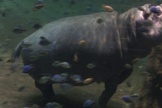
[image error]
 Sometimes, the hippos would thrust upwards towards the water surface using both hind feet placed firmly apart.
Sometimes, the hippos would thrust upwards towards the water surface using both hind feet placed firmly apart.Credit: Courtesy of Matthew Bennett
View full size imageTo look for a modern comparison to these extinct animals, the researchers observed the swimming styles of two female common Nile hippopotamuses (Hippopotamus amphibius) through a glass tank at the Adventure Aquarium in Philadelphia.
Underwater, the Nile hippos would glide with their limbs folded beneath their bodies. They would occasionally scratch the bottom of the tank with one leg, dragging only their digits across the ground. Sometimes, the hippos would thrust upward, toward the water surface, using both of their hind legs. These movements were reflected in the shape of the ancient tracks, the researchers said.
Bennett said other swimming tracks of mammals likely have been uncovered but just haven't been recognized. These types of prints do not form clear sequences like footprints on land do, Bennett said. He also guessed that many researchers have tended to dismiss animal tracks in their quest for hominin footprints.
"[The hippo tracks] tell us about mammal locomotion in a near-zero-gravity environment," Bennett said in an email. "They show how different types of 'bottom walking' motion may be recorded as tracks. All of this helps us understand and interpret swim tracks made by much larger extinct animals, such as dinosaurs."
http://www.livescience.com/46286-swimming-hippos-fossil-tracks.html

Published on June 14, 2014 13:32
Happy Birthday, U.S. Army!
Published on June 14, 2014 13:05
In the Midst: 10 Tips for #Marketing Your Book
In the Midst: 10 Tips for #Marketing Your Book: Before you can sell your book, you need to market it. The book promotion professionals at iUniverse have established a few key marketin... 10 Tips for #Marketing Your Book
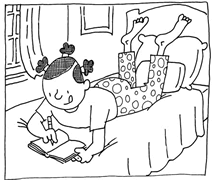
Before you can sell your book, you need to market it. The book promotion professionals at iUniverse have established a few key marketing tactics and tips to help you develop a great strategy for promoting your book.
· First, identify your book's target audience. Many authors make the mistake of thinking everyone is a potential reader, when in reality, some people are more likely to purchase the book than others. Would your book appeal more to females or males? What age range best represents your readers? Where do they live? What kind of activities do they pursue? The more you can narrow your focus, the easier it will be to locate your audience and promote your book
· Market and promote your book locally, then gradually expand your efforts. Create advertisements, such as business cards, posters and fliers, that will catch your target audiences' eye and that can be used on all levels. However, as a general rule, promoting your book locally is your best bet. Regional and national media will not be interested in you or your book until you have generated local attention. It is much easier for new authors to gain attention from local media outlets—such as newspapers, television and radio.
· Create an "elevator pitch" about your book. An "elevator pitch" is a brief, focused message aimed toward a particular person or group that summarizes why they should be interested in your book. Your elevator pitch should be no longer than two or three sentences and should focus on your book's selling points—those qualities that make it unique and special.
· Network, network, network. Positive word-of-mouth publicity is an essential part of any book marketing plan. Start by telling your friends and family about your book. Then broaden your reach to include coworkers and professional acquaintances. The next step for promoting your book might be to inform local organizations such as clubs, churches, synagogues and book clubs. You can also network over the Internet by searching for organizations interested in your book's topic.
· Create a professional looking media kit. This public relations tool will allow you to have your materials well organized. Before you can gain attention for your book, you should compile information about it that you can send out to the media. Your media kit should include a pitch letter introducing yourself and your book, an excerpt from your book or a copy of it, your author bio and photo, any positive endorsements or reviews you've received, sample interview questions and news articles or clippings related to your book's topic. Your media kit will be the first impression that editors, producers, reviewers or reporters have of you and your book, so make sure there are no spelling or grammatical errors.
· Utilize one of the most effective marketing vehicles, the World Wide Web. The growth of the Internet has been advantageous to authors and publishers as it has presented new forums to find targeted groups of people, build awareness of books, and make purchasing fast and easy. There are many Online Marketing tools available to you in order for you to best promote your book.
· When promoting your book to the media, pitch story ideas, not your book. Many authors make the mistake of merely telling the media that they've written a book, hoping for a book review or interview. Think about the types of interviews you hear on the radio or see on television and the articles you've read in newspaper and magazines. They are almost always centered on providing helpful information, and to a lesser degree, entertainment. If your book is nonfiction, think about the specialized information that it offers, then make a tip sheet that lists the top 10 ideas from your book. If your book is fiction, is there an interesting story behind why you wrote it? What makes you an expert on the subject?
· Always follow up. After you send out your media kits, don't just wait for a response; following up with your recipients by phone is imperative. It's much more difficult for someone to ignore you when you call them. Plus, contacting them more than once shows that you have persistence and drive. Don't become a pest while promoting your book, though. If someone doesn't respond after three contact attempts, it's probably best to move on.
· Enter your book in competitions. Winning a competition is a major endorsement for your book; awards help with book publicity by verifying that your book is head and shoulders above many others. Start by looking for contests that don't require steep entry fees or the submission of an inordinate number of books. There are also many contests related to specific genres like mystery or romance. It's also best to find contests that are especially welcoming to independently published or print-on-demand books. You can find contests by searching the Internet or reading the monthly iUniverse Author Newsletter.
· Don't give up. Promoting your book is not a task that you can do in a day, a week or even a month. Often, the fruits of your efforts won't be immediately evident. It takes time and persistence to get your book noticed. Be prepared for some rejection, but remember to celebrate every achievement.
Information contributed by: http://www.iuniverse.com/ExpertAdvice/MarketingYourBook1.aspx


Before you can sell your book, you need to market it. The book promotion professionals at iUniverse have established a few key marketing tactics and tips to help you develop a great strategy for promoting your book.
· First, identify your book's target audience. Many authors make the mistake of thinking everyone is a potential reader, when in reality, some people are more likely to purchase the book than others. Would your book appeal more to females or males? What age range best represents your readers? Where do they live? What kind of activities do they pursue? The more you can narrow your focus, the easier it will be to locate your audience and promote your book
· Market and promote your book locally, then gradually expand your efforts. Create advertisements, such as business cards, posters and fliers, that will catch your target audiences' eye and that can be used on all levels. However, as a general rule, promoting your book locally is your best bet. Regional and national media will not be interested in you or your book until you have generated local attention. It is much easier for new authors to gain attention from local media outlets—such as newspapers, television and radio.
· Create an "elevator pitch" about your book. An "elevator pitch" is a brief, focused message aimed toward a particular person or group that summarizes why they should be interested in your book. Your elevator pitch should be no longer than two or three sentences and should focus on your book's selling points—those qualities that make it unique and special.
· Network, network, network. Positive word-of-mouth publicity is an essential part of any book marketing plan. Start by telling your friends and family about your book. Then broaden your reach to include coworkers and professional acquaintances. The next step for promoting your book might be to inform local organizations such as clubs, churches, synagogues and book clubs. You can also network over the Internet by searching for organizations interested in your book's topic.
· Create a professional looking media kit. This public relations tool will allow you to have your materials well organized. Before you can gain attention for your book, you should compile information about it that you can send out to the media. Your media kit should include a pitch letter introducing yourself and your book, an excerpt from your book or a copy of it, your author bio and photo, any positive endorsements or reviews you've received, sample interview questions and news articles or clippings related to your book's topic. Your media kit will be the first impression that editors, producers, reviewers or reporters have of you and your book, so make sure there are no spelling or grammatical errors.
· Utilize one of the most effective marketing vehicles, the World Wide Web. The growth of the Internet has been advantageous to authors and publishers as it has presented new forums to find targeted groups of people, build awareness of books, and make purchasing fast and easy. There are many Online Marketing tools available to you in order for you to best promote your book.
· When promoting your book to the media, pitch story ideas, not your book. Many authors make the mistake of merely telling the media that they've written a book, hoping for a book review or interview. Think about the types of interviews you hear on the radio or see on television and the articles you've read in newspaper and magazines. They are almost always centered on providing helpful information, and to a lesser degree, entertainment. If your book is nonfiction, think about the specialized information that it offers, then make a tip sheet that lists the top 10 ideas from your book. If your book is fiction, is there an interesting story behind why you wrote it? What makes you an expert on the subject?
· Always follow up. After you send out your media kits, don't just wait for a response; following up with your recipients by phone is imperative. It's much more difficult for someone to ignore you when you call them. Plus, contacting them more than once shows that you have persistence and drive. Don't become a pest while promoting your book, though. If someone doesn't respond after three contact attempts, it's probably best to move on.
· Enter your book in competitions. Winning a competition is a major endorsement for your book; awards help with book publicity by verifying that your book is head and shoulders above many others. Start by looking for contests that don't require steep entry fees or the submission of an inordinate number of books. There are also many contests related to specific genres like mystery or romance. It's also best to find contests that are especially welcoming to independently published or print-on-demand books. You can find contests by searching the Internet or reading the monthly iUniverse Author Newsletter.
· Don't give up. Promoting your book is not a task that you can do in a day, a week or even a month. Often, the fruits of your efforts won't be immediately evident. It takes time and persistence to get your book noticed. Be prepared for some rejection, but remember to celebrate every achievement.
Information contributed by: http://www.iuniverse.com/ExpertAdvice/MarketingYourBook1.aspx

Published on June 14, 2014 04:20




